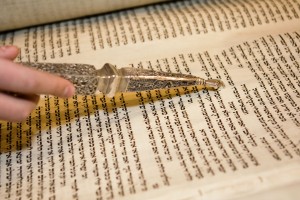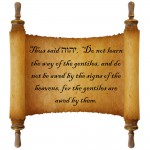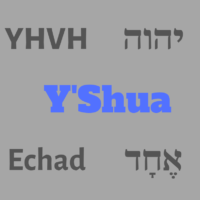0. Introduction: Many Messianic believers have become accustomed to use the “standard Jewish†annual cycle of weekly readings from the 5 Books of Moshe, plus extracts from the remainder of the Tanak, coupled perhaps with parallel readings from the B’rit Chadashah. However it seems common cause that, particularly after a few years, the readers or congregation begin to feel that “there’s just so much†in a week’s parasha that there isn’t enough time to study it properly. The more you understand, the more questions you have and the more understanding you seek. This Enquiry arises out of such a situation, and presents some options.
readings from the 5 Books of Moshe, plus extracts from the remainder of the Tanak, coupled perhaps with parallel readings from the B’rit Chadashah. However it seems common cause that, particularly after a few years, the readers or congregation begin to feel that “there’s just so much†in a week’s parasha that there isn’t enough time to study it properly. The more you understand, the more questions you have and the more understanding you seek. This Enquiry arises out of such a situation, and presents some options.
1.The Annual Lectionary Cycle: This is available for download from, for example, www.ffoz.org including BC parallel readings, or from numerous Jewish sites without them. It is used extensively but not exclusively by Jewish congregations worldwide. It tends to mesh fairly well with the annual cycle of 7 Feasts, or at least you begin to recognise when a feast is due… Rarely is it realised that this cycle was not used in Judea during the time of Yahusha’s ministry, but migrated across from the Babylonian Jewry to Palestine some time later.
2.The 3-year Cycles: Basically there are 2 approaches to going through the entire Pentateuch in 3 years, and they could be used equally well for a 2,3,4,5-year cycle or any other. The first is simply to break each weekly parasha for the standard annual cycle into the requisite number of chunks, and to munch steadily through them one after the other, a week for each. Obviously the meshing with the feast calendar tends to be lost, and you may find it difficult to get a commentator who is staying in synch with you, but you can with a little work cut your cake to suit your own needs.
The second keeps the original meshing, but could be frustrating. Doing the same chunking as above, one uses in the first year just the first chunk from each week’s parasha; in the second year you use the second chunk, in the third year the third chunk, etc. I think I would find the discontinuity and loss of context introduced by this very disturbing.
3.The “Triennial†Cycle: “Triennial†should mean “3-yearly†but it has a special application here, actually meaning roughly 3½ years. In fact the underlying concept is a septennial (7-year) cycle made up of two “triennial†cycles. The idea is to start reading Beresheit 1:1 at the beginning of the 7th month and to end three and a half years later with the end of Debarim a couple of weeks before Pesach; then to resume from Ber 1:1, ending up with Debarim 34 just before Yom Teruach 3½ years later. This approach, little-known apparently in Messianic circles, seems to have been the standard practice of Palestinian synagogues for centuries before and after the Apostolic Century, and fits in with the 7-year shmita cycle which was the natural cycle for Israel to hear the Torah read to them and (enjoying their agricultural shabbat year) have time to discuss and consider what they had heard (check Ezra/Nehemiah, also Dev 31:10-12). It results in reading about 1 chapter of Torah per week plus parts from the later books.
We’re now a full year into the current shmita cycle, so this is not a particularly good opportunity to jump onto the triennial/septennial cycle; but those who are keen could start straight after the Sukkoth special readings (all the different cycles have special readings inserted for the feasts), on Simchat Torah to be precise.
The list of readings (parashot) is carefully constructed to accommodate the differing numbers of weeks in the years (e.g. for 13-month years in contrast to 12-month years). Apparently the effect is to highlight the Feasts and other significant happenings from a variety of perspectives.
A briefly-commented listing for the current cycle is available from Greg Kilian at
and a full, possibly bewildering, rather “Jewish†discussion at
Say among all the nations: YHWH reigns!     © Basil Fernie  January 2010










Leave a Reply